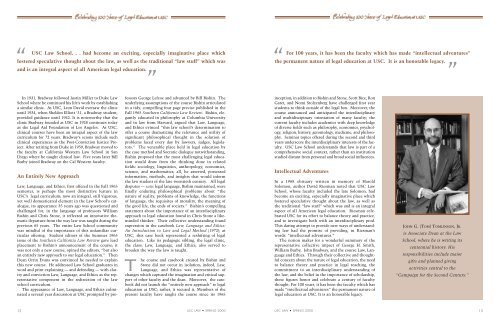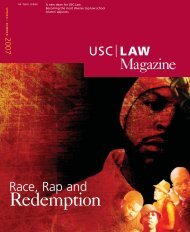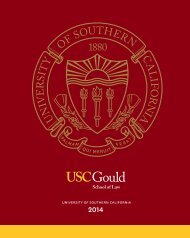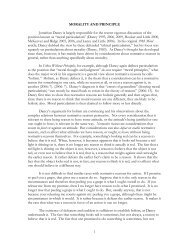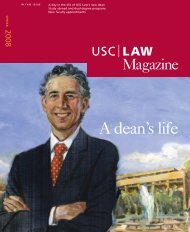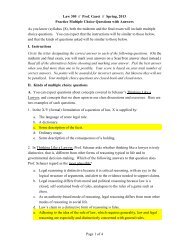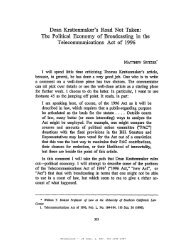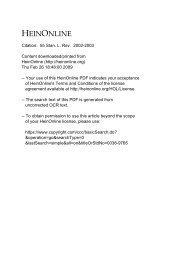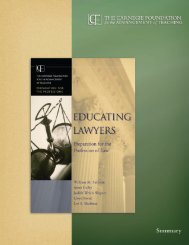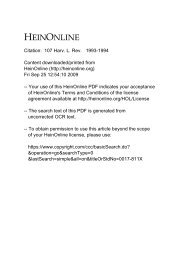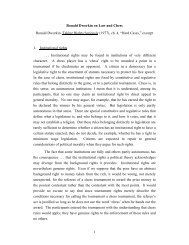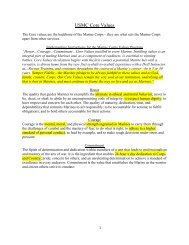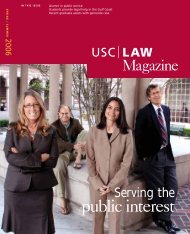Dean Scott H. Bice - USC Gould School of Law - University of ...
Dean Scott H. Bice - USC Gould School of Law - University of ...
Dean Scott H. Bice - USC Gould School of Law - University of ...
Create successful ePaper yourself
Turn your PDF publications into a flip-book with our unique Google optimized e-Paper software.
“<strong>USC</strong> <strong>Law</strong> <strong>School</strong>. . . had become an exciting, especially imaginative place whichfostered speculative thought about the law, as well as the traditional “law stuff” which wasand is an integral aspect <strong>of</strong> all American legal education.““For 100 years, it has been the faculty which has made “intellectual adventures”the permanent nature <strong>of</strong> legal education at <strong>USC</strong>. It is an honorable legacy.“In 1931, Bradway followed Justin Miller to Duke <strong>Law</strong><strong>School</strong> where he continued his life’s work by establishinga similar clinic. At <strong>USC</strong>, Leon David oversaw the clinicuntil 1934, when Shelden Elliott ‘31, a Bradway student,provided guidance until 1942. It is noteworthy that theclinic Bradway founded at <strong>USC</strong> in 1928 continues todayas the Legal Aid Foundation <strong>of</strong> Los Angeles. At <strong>USC</strong>,clinical courses have been an integral aspect <strong>of</strong> the lawcurriculum for 72 years. Bradway’s scions include suchclinical experiences as the Post-Conviction Justice Project.After retiring from Duke in 1959, Bradway moved tothe faculty at California Western <strong>Law</strong> <strong>School</strong> in SanDiego where he taught clinical law. Five years later BillBurby joined Bradway on the Cal Western faculty.An Entirely New Approach<strong>Law</strong>, Language, and Ethics, first <strong>of</strong>fered in the Fall 1965semester, is perhaps the most distinctive feature in<strong>USC</strong>’s legal curriculum; now an integral, still vigorous,yet well domesticated element in the <strong>Law</strong> <strong>School</strong>’s catalogue,its appearance 35 years ago was questioned andchallenged for, in the language <strong>of</strong> pr<strong>of</strong>essors WilliamBishin and Chris Stone, it reflected an innovative thematicdeparture from the way law was taught during theprevious 65 years. The entire <strong>Law</strong> <strong>School</strong> communitywas mindful <strong>of</strong> the importance <strong>of</strong> this unfamiliar curricular<strong>of</strong>fering. Student editors <strong>of</strong> the Summer 1965issue <strong>of</strong> the Southern California <strong>Law</strong> Review gave leadplacement to Bishin’s announcement <strong>of</strong> the course; itwas not only a new course, opined the editors, “but alsoan entirely new approach to our legal education.” Then<strong>Dean</strong> Orrin Evans was convinced he needed to explainthis new course. He addressed <strong>Law</strong> <strong>School</strong> graduates inword and print explaining — and defending — with clarityand conviction <strong>Law</strong>, Language, and Ethics as the representativecomponent in the redirection <strong>of</strong> the lawschool curriculum.The appearance <strong>of</strong> <strong>Law</strong>, Language, and Ethics culminateda several year discussion at <strong>USC</strong> prompted by pr<strong>of</strong>essorsGeorge Lefcoe and advanced by Bill Bishin. Theunderlying assumptions <strong>of</strong> the course Bishin articulatedin a tidy, compelling four page precise published in theFall 1965 Southern California <strong>Law</strong> Review. Bishin, elegantlyeducated in philosophy at Columbia <strong>University</strong>and in law from Harvard, argued that <strong>Law</strong>, Language,and Ethics evinced “this law school’s determination to<strong>of</strong>fer a course dramatizing the relevance and utility <strong>of</strong>significant philosophical thought in the solution <strong>of</strong>problems faced every day by lawyers, judges, legislators.”The venerable place held in legal education bythe case method and Socratic dialogue notwithstanding,Bishin proposed that the most challenging legal educationwould draw from the thinking done in relatedfields: sociology, linguistics, anthropology, economics,science, and mathematics; all, he asserted, possessedinformation, methods, and insights that would informthe law student <strong>of</strong> the late twentieth century. All legaldisputes — sans legal language, Bishin maintained, werefinally enduring philosophical problems about “thenature <strong>of</strong> reality, problems <strong>of</strong> knowledge, the functions<strong>of</strong> language, the requisites <strong>of</strong> morality, the meaning <strong>of</strong>the good life, the ends <strong>of</strong> society.” Bishin’s compellingstatement about the importance <strong>of</strong> an interdisciplinaryapproach to legal education found in Chris Stone a likemindedthinker. Their collective understanding foundexpression in the casebook <strong>Law</strong>, Language and Ethics:An Introduction to <strong>Law</strong> and Legal Method (1972); at<strong>USC</strong>, this case book represented a reshifting <strong>of</strong> legaleducation. Like its pedagogic sibling, the legal clinic,the class, <strong>Law</strong>, Language, and Ethics, also served tobroaden the way the law is taught.The course and casebook created by Bishin andStone did not occur in isolation; indeed, <strong>Law</strong>,Language, and Ethics was representative <strong>of</strong>changes which captured the imagination and critical support<strong>of</strong> other faculty and the dean. Moreover, the casebookdid not launch the “entirely new approach” to legaleducation at <strong>USC</strong>; rather, it secured it. Members <strong>of</strong> thepresent faculty have taught the course since its 1965inception; in addition to Bishin and Stone, <strong>Scott</strong> <strong>Bice</strong>, RonGaret, and Nomi Stolzenberg have challenged first yearstudents to think outside <strong>of</strong> the legal box. Moreover, thecourse announced and anticipated the interdisciplinaryand multidiscipinary orientation <strong>of</strong> many faculty; thecurrent faculty includes academics with deep knowledge<strong>of</strong> diverse fields such as philosophy, economics, psychology,religion, history, gerontology, medicine, and philosophy.Seminar topics <strong>of</strong>fered during the second and thirdyears underscore the interdisciplinary interests <strong>of</strong> the faculty.<strong>USC</strong> <strong>Law</strong> <strong>School</strong> understands that law is part <strong>of</strong> acomprehensive social context, rather than an institutionstudied distant from personal and broad social influences.Intellectual AdventuresIn a 1968 obituary written in memory <strong>of</strong> HaroldSolomon, author David Riesman noted that <strong>USC</strong> <strong>Law</strong><strong>School</strong>, whose faculty included the late Solomon, hadbecome an exciting, especially imaginative place whichfostered speculative thought about the law, as well asthe traditional “law stuff” which was and is an integralaspect <strong>of</strong> all American legal education. Riesman celebrated<strong>USC</strong> for its effort to balance theory and practice,and to investigate both with an interdisciplinary prod.This daring attempt to provide new ways <strong>of</strong> understandinglaw had the promise <strong>of</strong> providing, in Riesman’swords: “intellectual adventures.”The notion makes for a wonderful summary <strong>of</strong> therepresentative collective impact <strong>of</strong> George H. Smith,William Burby, John Bradway, and the course <strong>Law</strong>, Languageand Ethics. Through their collective and thoughtfulconcern about the nature <strong>of</strong> legal education, the needto balance theory and practice in legal teaching, thecommitment to an interdisciplinary understanding <strong>of</strong>the law, and the belief in the importance <strong>of</strong> scholarship,these figures honor and celebrate a century <strong>of</strong> facultythought. For 100 years, it has been the faculty which hasmade “intellectual adventures” the permanent nature <strong>of</strong>legal education at <strong>USC</strong>. It is an honorable legacy.JOHN G. (TOM) TOMLINSON, JR.is Associate <strong>Dean</strong> at the <strong>Law</strong><strong>School</strong>, where he is writing itscentennial history. Hisresponsibilities include majorgifts and planned givingactivities central to the“Campaign for the Second Century.”12 <strong>USC</strong> LAW • SPRING 2000 <strong>USC</strong> LAW • SPRING 200013


